Le Tastevin - November 16, 2016 - 2000 Bordeaux (Hosts: Bordeaux Joe & Dave)
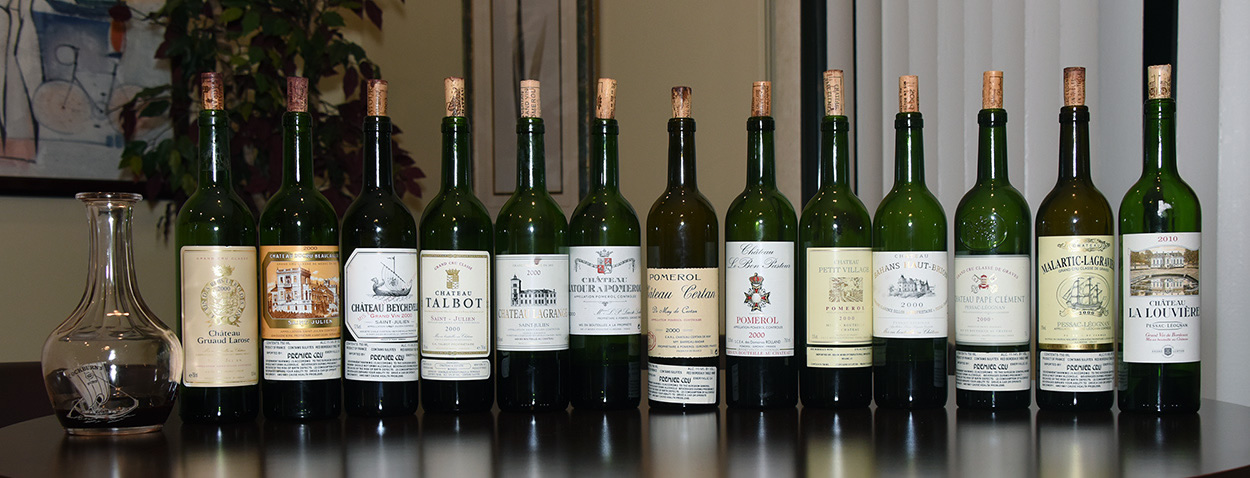 Tonight's tasting continued our sampling of Bordeaux wines from the 2000 vintage. The year began poorly, with cool, damp weather leading to mildew that required a lot of treatment to the vines. May-July weather was punctuated with alternating periods of heat and cool temperatures. What seemed like a very mediocre vintage changed dramatically in August and September with perfect conditions, often with hot weather and clear skies. Soon, wine makers realized they had a special vintage, with even lesser growers harvesting excellent grapes. These wines are ripe and concentrated, balanced and silky tannins, and good acidity, and should evolve for decades. As noted in the Wikipedia entry for "Château": "many estates do have true châteaux on them in Bordeaux, but it is customary for any wine-producing estate, no matter how humble, to prefix its name with "Château"."
Tonight's tasting continued our sampling of Bordeaux wines from the 2000 vintage. The year began poorly, with cool, damp weather leading to mildew that required a lot of treatment to the vines. May-July weather was punctuated with alternating periods of heat and cool temperatures. What seemed like a very mediocre vintage changed dramatically in August and September with perfect conditions, often with hot weather and clear skies. Soon, wine makers realized they had a special vintage, with even lesser growers harvesting excellent grapes. These wines are ripe and concentrated, balanced and silky tannins, and good acidity, and should evolve for decades. As noted in the Wikipedia entry for "Château": "many estates do have true châteaux on them in Bordeaux, but it is customary for any wine-producing estate, no matter how humble, to prefix its name with "Château"."
Starter, White
Château La Louvière, Pessac-Leognan
Most acreage is devoted to producing red wines, but 13.5 hectares are reserved for Sauvignon Blanc (85%) and Sémillon (15%). Buttery, honeyed with sweet tones, this wine is mostly Sauvignon with some Sémillon (cepage varies year-to-year). Owned by Les Vignobles André Lurton, the company is headquarted at Château Bonnet in Grézillac where André Lurton was born.
Reds
Château Malartic-Lagravière, Pessac-Leognan
RP - 90, WS - 92. Under supervision of the Bonnie family, who bought this property in 1997 and subsequently renovated with state-of-the-art facilities. White wines are characterized as intense.
Château Pape Clément, Pessac-Leognan
RP - 96, drink 2011-2031. Part of the Bernard Magrez group, whose direction has brought this property closer to the quality of its neighbors, Haut-Brion and La Mission Haut-Brion. Made from vines of 40-45 years old, 11,000 cases were made. The cepage was 60% Cabernet Sauvignon, 30% Merlot, and 10% Cabernet Franc aged in 60-80% new oak. A second label, Le Clémentin, is made, as is an excellent, limited-edition white.
Château Bahans Haut-Brion, Pessac-Leognan
WS - 90. Classified as a 5th growth, this is a second label of Château Haut-Bion. Renamed Clarence Haut-Brion in 2007, it is favored by some critics.
Château Petit Village, Pomerol
RP & WS - 90. A relative large estate, this vintage was made from 80% Merlot, 10% Cabernet Sauvignon, and 10% Cabernet Franc aged in 100% new oak for at least 14 months.
Château Le Bon Pasteur, Pomerol
RP - 94, WS - 90. Parker raves about the owners and oenologists Dany and Michel Rolland, who he describes as overachieving wines from not the finest terroir. Indeed, he rates the 2000 as one of the best of Pomerol.
Château Certan DeMay, Pomerol
RP & WS - 91. Vines are planted on 12 acres of outstanding terroir, this wine is 70% Merlot, 25% Cabernet Franc and 5% Cabernet Sauvignon aged in 40% new oak. Under 1,800 cases are produced. Michel Rollan of Le Bon Pasteur was brought in as a consultant in 2004 and upped the quality.
Château LaTour a Pomerol, Pomerol
RP - 91+, WS - 95. The greatest wine was made from the 1940s through the 1960s by the Libourne firm of Jean-Pierre Moueix, it has since never reachieved it glory. Still, very good wine is made. The cepage of this wine was 70% Merlot, 25% Cabernet Franc, and 5% Cabernet Sauvignon.
Château Lagrange, St. Julien
RP - 87. 110 hectares are owned by the Japanese liquor giant Suntory, planted with 65% Cabernet Sauvignon, 28% Merlot and 7% Petit Verdot. Some holdings planted with white varieties include 53% Sauvignon Blanc, 36% Semillon, and 11% Muscadelle. The 2000 vintage, of which 60,000 cases were produced, was aged 21 months in 60% new oak.
Château Talbot, St. Julien
RP - 90, WS - 93. Perhaps the largest vineyard in Médoc, with 121 hectares under cultivation. This vintage's cepage was 52% Cabernet Sauvignon, 41% Merlot, 4% Petit Verdot and 3% Cabernet Franc aged in 50-60% new oak. 25,000 cases made.
Château Beychevelle, Jt. Julien
RP - 91, WS - 92. Originally classified as a 4th growth. Cepage of the 2000 vintage was 52% Cabernet Sauvignon, 40% Merlot, 5% Cabernet Franc, and 3% Petit Verdot aged 18 months. 25,000 cases were produced. In the past, Parker notes that Beychevelle "remains the most conspicuous underachiever in the otherwise brilliant appelation of St.-Julien," it has shown improvement. The wine label is of a sailing ship with the sails lowered, which led many Chinese to called it Dragon Boat wine, and greatly boast its popularity and sales. Estate is a huge tourist draw in Médoc.
Château Ducru-Beaucaillou, St. Julien
RP - 95, WS - 95, drink 2015-2035. Cepage of the 2000 vintage is 70% Cabernet Sauvignon, 30% Merlot aged in 70-90% new oak.
Château Gruaud Larose, St. Julien
WS - 95. Prices for this wine, commensurate with quality, have increased 3-4X as the owners reduced production in the 1980s from 25,000 cases to about 8,000 today. The 2000 vintage was made from 65% Cabernet Sauvignon, 29% Merlot, 3% Cabernet Franc, 2% Petit Verdot and 1% Malbec fermeted in 60% cement and 40% oak.
Dessert
Château de Fargues, Sauternes
La Revue du Vin de France 92, 1,000-1,200 cases, 80% Semillon, 20% Sauvignon Blanc. Owned by the Lur-Saluces family, Chateau de Fargues is also known as d'Yquem junior.
Images of the wines sampled:.
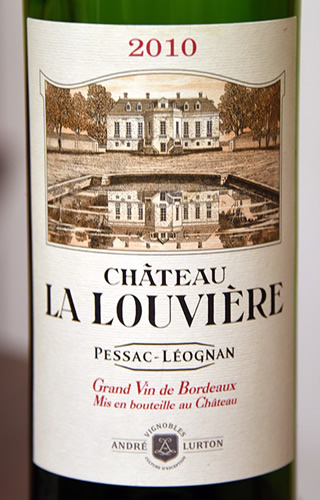
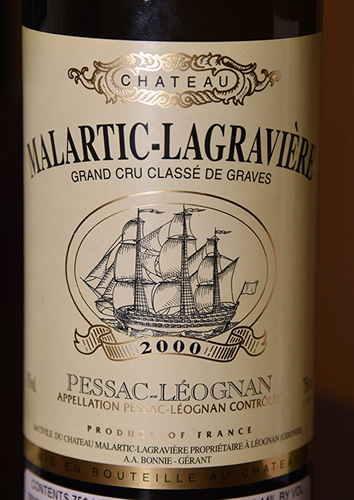

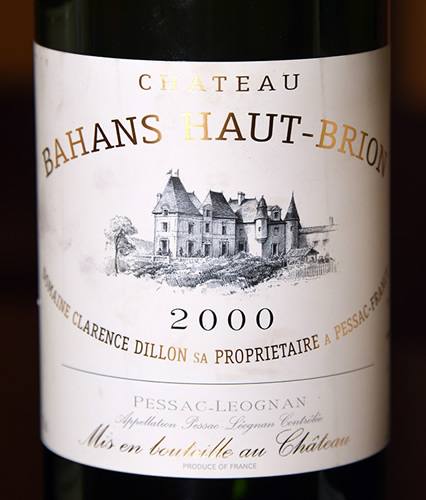
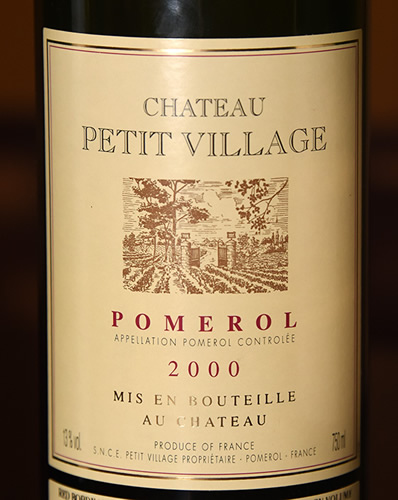
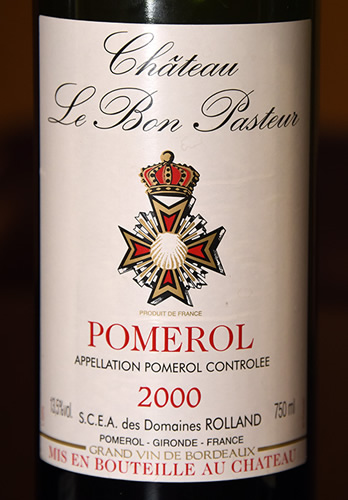

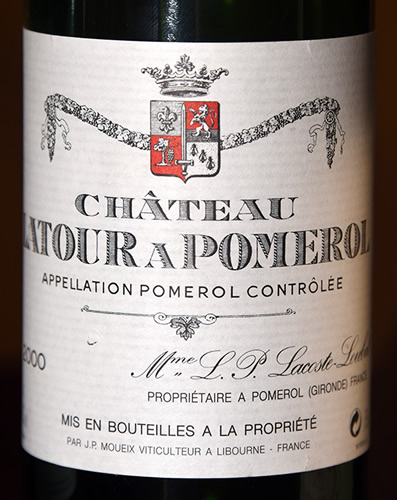
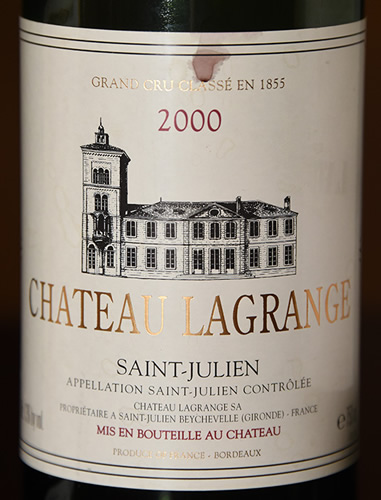
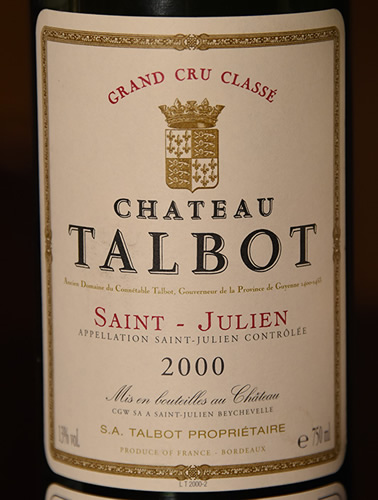

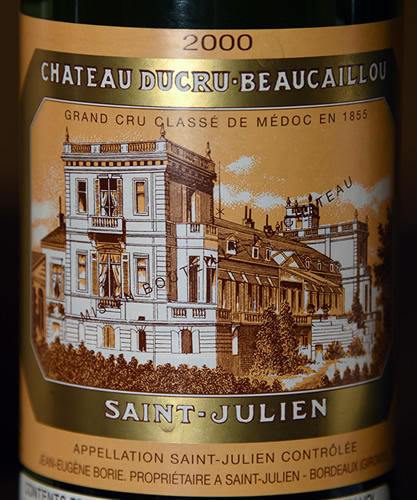

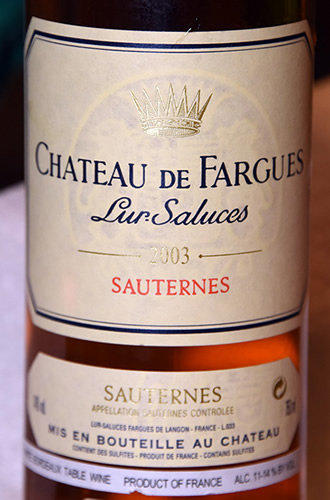
Page last edited: November 19, 2016 (EB)
